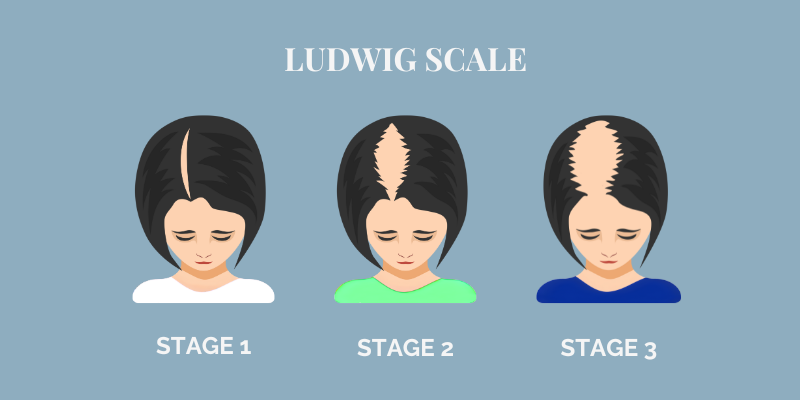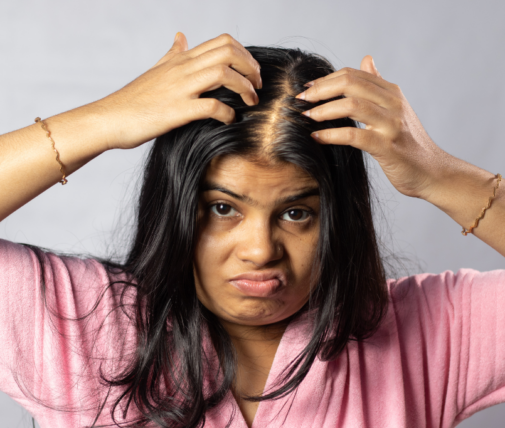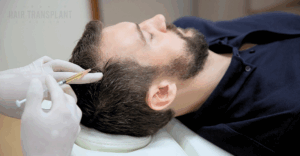Hair loss in women is a topic that affects millions across the globe. It is more than just a cosmetic issue; it can lead to emotional distress, lowered self-esteem, and even social isolation. Hair loss can be caused by a range of factors including genetics, hormonal changes, stress, or underlying medical conditions. Fortunately, there are treatments and preventative measures available to help women regain control over their hair health. In this post, we will dive deep into the types of hair loss women experience.
Types and Causes of Hair Loss in Women
There are several types of hair loss that women can experience, each with different causes and characteristics:
- Androgenetic Alopecia (Female Pattern Hair Loss):
• The most common type of hair loss in women, often hereditary. This condition is largely genetic and often becomes noticeable as a gradual thinning of hair, particularly on the crown of the head. Unlike male pattern baldness, women rarely experience complete baldness with androgenetic alopecia. It typically leads to gradual thinning on the crown or top of the scalp while the hairline remains intact. - Telogen Effluvium:
• Telogen effluvium is a temporary condition in which hair sheds excessively. This can be triggered by physical or emotional stress, such as childbirth, surgery, or extreme weight loss. In telogen effluvium, the hair growth cycle is interrupted, causing large amounts of hair to enter the resting (telogen) phase and subsequently fall out. - Alopecia Areata:
• An autoimmune condition where the immune system attacks hair follicles, leading to sudden, patchy hair loss. This condition can appear suddenly and may progress to total hair loss in some cases. Early signs include small, round bald patches on the scalp, and it can affect other areas such as the eyebrows and eyelashes. In more severe cases, it can progress to total hair loss on the scalp (alopecia totalis) or the entire body (alopecia universalis). - Traction Alopecia:
• Caused by consistent pulling or tension on the hair due to tight hairstyles like ponytails, braids, or extensions. This form of hair loss is often preventable by changing styling practices. - Anagen Effluvium:
• Often seen during chemotherapy or radiation therapy, this type of hair loss occurs during the active growth phase of the hair cycle, leading to rapid shedding of large amounts of hair. - Scarring Alopecia (Cicatricial Alopecia):
• A rare form of hair loss caused by inflammation that destroys hair follicles and leads to permanent hair loss. It can result from conditions like lichen planopilaris or frontal fibrosing alopecia. - Trichotillomania:
• A psychological condition where a person compulsively pulls out their own hair, leading to noticeable bald patches.
Each type of hair loss requires specific treatment, so proper diagnosis by a healthcare provider or dermatologist is crucial for effective management.

The Ludwig Scale for Female Pattern Hair Loss (FPHL)
The Ludwig Scale classifies female pattern baldness into three stages:
1. Stage 1 – Mild thinning on the crown or top of the head, with a slightly wider part line, but the hairline remains intact.
2. Stage 2 – Moderate thinning, where the scalp becomes more visible, and hair shedding increases. The hair at the top of the head and crown noticeably thins.
3. Stage 3 – Severe thinning, with a significant reduction in hair density on the crown and top of the head, leaving the scalp highly visible.
Understanding these specific patterns of hair loss in women is essential for early detection and appropriate treatment, as the progression can be slow and subtle, often going unnoticed until significant thinning has occurred. Recognizing the signs early allows women to seek treatments that may help slow or even reverse hair loss.
What are the early signs of hair loss in women?
The early signs of hair loss in women can be subtle, but recognizing them early can help with timely intervention and treatment. Here are the most common early signs:
1. Thinning Hair at the Part Line:
• One of the earliest signs of hair loss in women is a gradual thinning along the part line. The part may become wider, making the scalp more visible.
2. Increased Shedding:
• Noticing more hair fall than usual, especially during brushing, washing, or styling, can indicate hair loss. Normally, losing about 50 to 100 hairs a day is typical, but excessive shedding could signal an issue.
3. Visible Scalp:
• As hair thins, especially on the crown of the head, more scalp may become visible. This diffuse thinning is common in female pattern hair loss.
4. Difficulty Styling Hair:
• Women often notice their hair feels thinner and less voluminous, making it harder to style in ways that it used to. The hair might not hold volume or shape as it did before.
5. Brittle Hair and Breakage:
• Hair may start to feel dry, weak, and prone to breakage, leading to shorter, uneven lengths.
6. Receding Hairline (Less Common):
• Although not as common as in men, some women may notice a receding hairline, especially around the temples. This is often associated with traction alopecia or androgenetic alopecia.
7. Overall Loss of Density:
• A general reduction in hair density or thickness across the entire scalp can occur, leading to a less full appearance.
If you notice any of these signs, it’s a good idea to consult with a healthcare provider or dermatologist to determine the cause and explore treatment options. Early detection can significantly improve the chances of slowing or reversing hair loss.
Symptoms of Hair Loss in Women
Hair loss in women typically manifests in several distinct ways that differ from the patterns seen in men. Common signs of hair loss in women include:
- Gradual Thinning at the Part Line: One of the earliest and most noticeable signs of hair loss in women is the slow thinning of hair along the natural part line. This type of thinning often happens gradually, making it difficult to detect at first. Over time, the part line becomes more visible as the density of hair decreases in this area.
- Diffuse Hair Loss Radiating from the Top of the Head: Rather than specific bald patches, women often experience diffuse hair loss that spreads across the crown or top of the head. This can give the appearance of overall thinning, making the scalp more visible without a clear point of origin for the hair loss. Unlike male pattern baldness, which typically affects specific areas, such as the temples or crown, diffuse thinning tends to affect a larger area of the scalp.
- Widening of the Mid-Line Part: As hair loss progresses, the mid-line part—where hair naturally falls—begins to widen. This can create a more noticeable gap between the sides of the part, as less hair remains to cover the scalp. This widening is often gradual but can become more pronounced over time, especially in cases of androgenetic alopecia (female pattern hair loss).
- Increased Shedding: Women experiencing hair loss often notice a significant increase in daily shedding. While losing some hair daily is normal (an average of 50-100 hairs), hair loss becomes concerning when shedding exceeds 125 hairs per day. Excessive shedding may be noticeable when brushing or washing the hair, or as more hair accumulates on pillows and in the shower drain.
Key Differences from Male Pattern Baldness
Unlike male pattern baldness, where hair loss frequently results in a receding hairline or bald spots, women rarely experience these symptoms. In most cases, the hairline remains intact, and complete baldness is extremely uncommon. Instead, the hair thins and becomes less voluminous, but the overall hairline typically stays in place. This difference is largely due to variations in how hormones like androgens affect hair follicles in men and women.
Restoring Confidence Through Hair Loss Solutions
At the Toronto Hair Transplant Surgeons, we regularly see female patients who are experiencing hair loss. Hair loss in women is a common yet emotionally challenging condition. However, with the right treatments and preventative measures, women can take control of their hair health and regain confidence. Whether it’s through lifestyle changes, medical treatments, or hair transplants, there are options available to combat hair loss and restore not only hair but also self-esteem.






